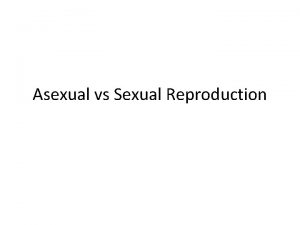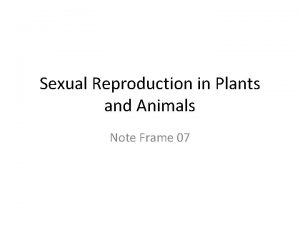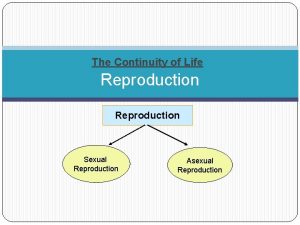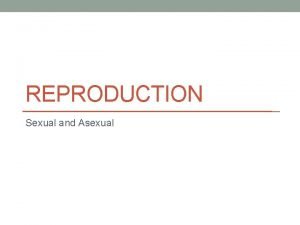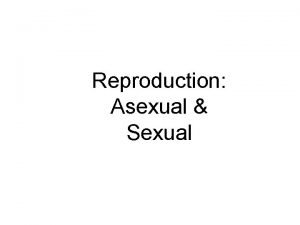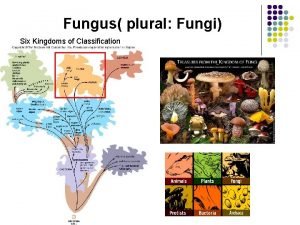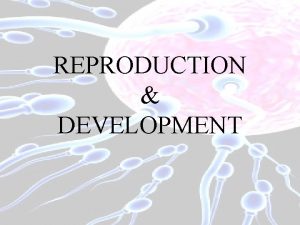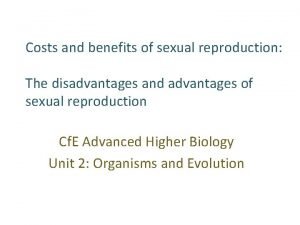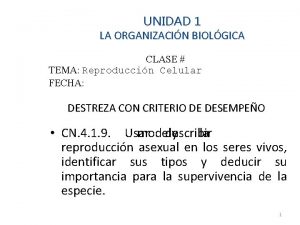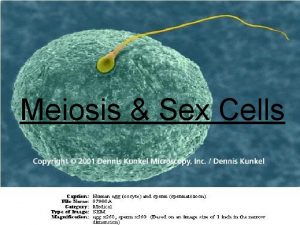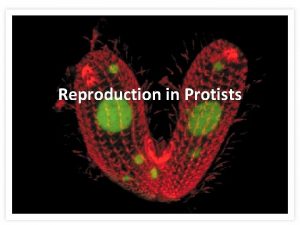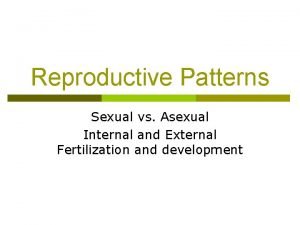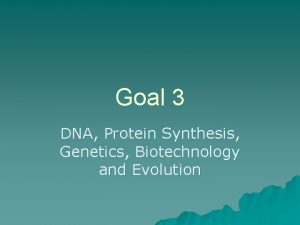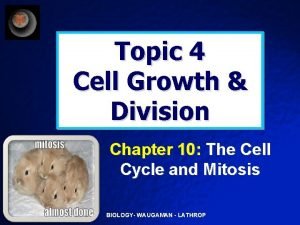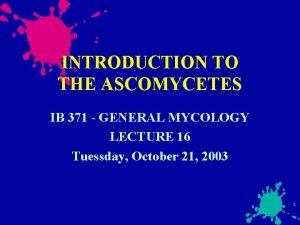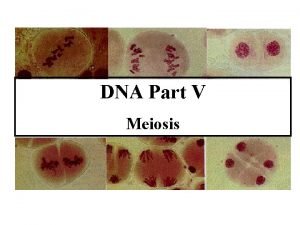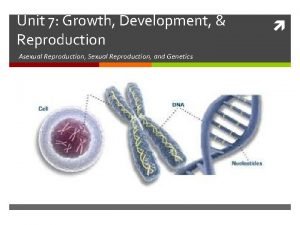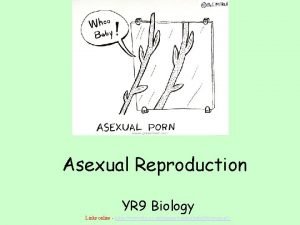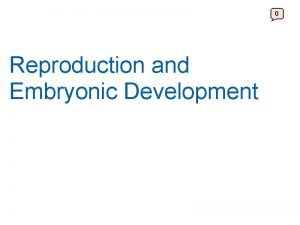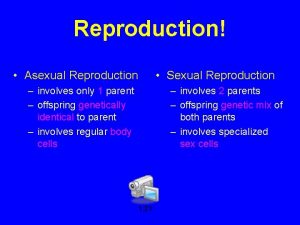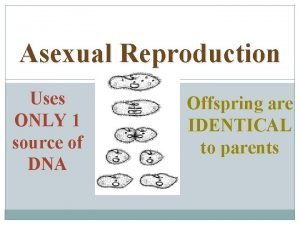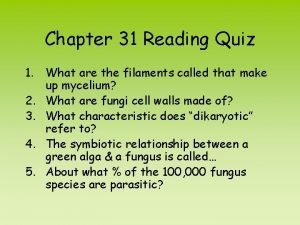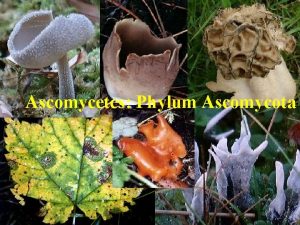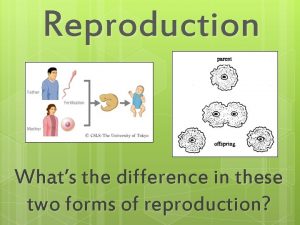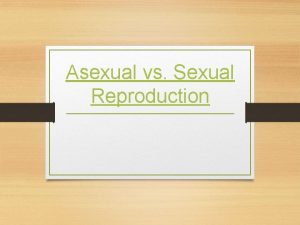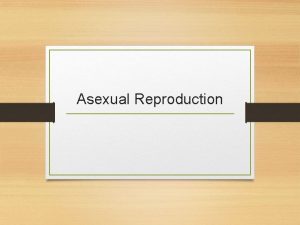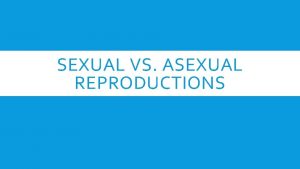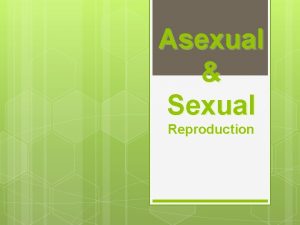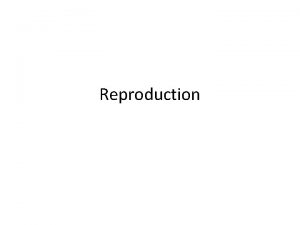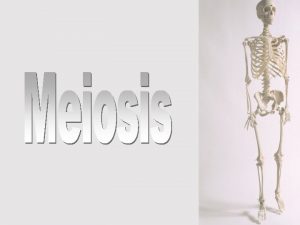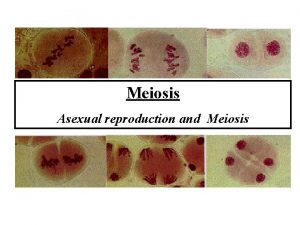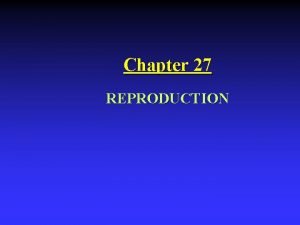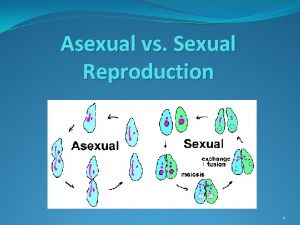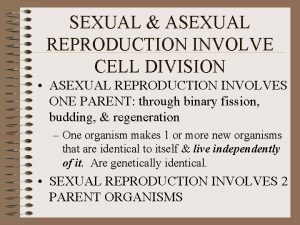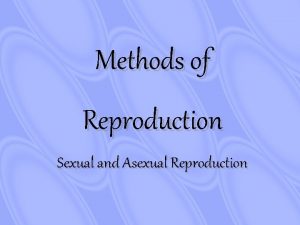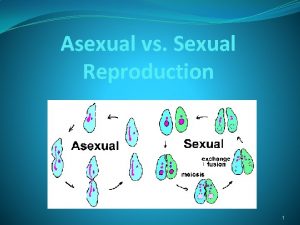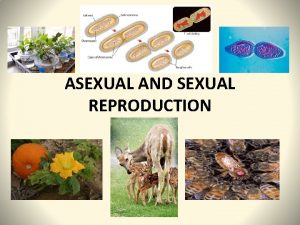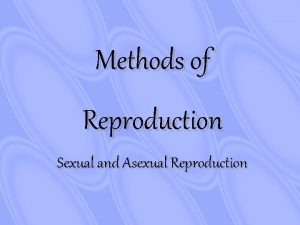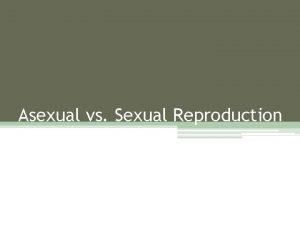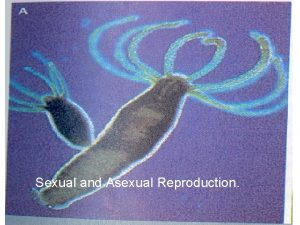11 Meiosis Meiosis Asexual vs sexual reproduction Steps












































- Slides: 44

11. Meiosis

Meiosis • Asexual vs. sexual reproduction • Steps of Meiosis 2

Cell division • Cloning/multiplicatio n: – exact genetic duplication – mitosis • Sexual reproduction: – combination of DNA from both parents – Specialized cells – Meiosis 3

Sexual Reproduction • Sexual reproduction – produces the next generation through genetic recombination between two individuals – Genetic recombination • Offspring inherit traits from both parents. • To inherit genes from both parents – Need to reduce the number of genes from each parent by half. 4

Why Sex? Sexual vs. asexual reproduction 5

Why Sex? Sexual vs. asexual reproduction • Compare and contrast • Asexual reproduction – No trait variability between parents and offspring – Except for mutation • Sexual reproduction – Produces a range of traits in offspring – Mutations cause additive variation 6

How many chromosomes? • Humans: 46 chromosomes per cell – Just before mitotic division: 46 pairs • Half from Mom (23) • Half from Dad (23) 7

Homologous Chromosomes • Chromosomes pairs • 2 chromosomes containing information for the same things – Genetic traits • 1 maternal • 1 paternal • Different from sister chromatids – Duplicate copies 8

Haploid/Diploid • Ploidy – sets of genes • Haploid (n) – One copy of each gene • Diploid (2 n) – Two copies of each gene 9

Haploid/Diploid • Reduce genes for sexual reproduction : – Go from Diploid to Haploid • Fertilization – Going from Haploid to Diploid (2 n) ➔ Haploid (n) ➔ Diploid (2 n) Meiosis Fertilization 10

Haploid / Diploid 11

Gametes • “Sex Cells” • Cells that have only 1 set of genes (Haploid) 12

Meiosis • Original diploid cell four haploid cells • Gametes are not identical. • Each gamete must contain one copy of each chromosome. 13

Meiosis • Meiosis I – Daughter cells are haploid, with 2 copies of each chromosome – Each chromosome from either parent • Meiosis II – Daughter cells have 23 chromosomes 14

Meiosis I • Chromosomes are aligned at metaphase in groups of 4, not 2. • Daughter cells have chromosome copies; random mix of maternal, paternal 15

Meiosis I 16

Meiosis I • Similar steps to Mitosis – Except instead of copies (sister chromatids) separating • Homologues chromosomes separate – Sister chromatids remain connected…for now 17

Meiosis II • Sister chromatids separate form haploid daughter cells (gametes) 18

Meiosis II 19

Meiosis I & II • Meiosis I – diploid cells consisting of duplicate chromosomes • Meiosis II – haploid cells consisting of only 1 copy of each chromosome 20

Mitosis vs. Meiosis 21

Crossing Over • Genetic exchange 22

Crossing Over • During – Prophase I & Metaphase I • Regions of the chromosomes can break and swap places with their homologs • Crossing Over 23

Recombination • Two Genes on the same chromosome • Alleles travel together (linkage disequilibrium) Gene A B 24

Recombination • Two Genes on the same chromosome • Example: – A mutant travels w/ B normal – A normal w/ B mutant Gene A B Mutant Alleles 25

Recombination • However, crossing over events can “shuffle” linked genes • Creating new combinations of alleles that travel together Gene A B Mutant Alleles X 26

Recombination • However, crossing over events can “shuffle” linked genes • Both mutants on the same chromosome Gene A B Mutant Alleles X 27

Independent assortment • Random assignment of maternal/paternal chromosomes to gametes – Humans 23 Homologous pairs: 8, 388, 608 possible combinations 28

Independent Assortment 29

Chromosome types • Autosomes – 22 pairs of homologous chromosomes • Sex chromosomes – XX = female – XY = Male 30

Sex Chromosomes X Y 31

Sex Determination • The sex of offspring determine by 1 set of genes • Sex determination genes – Inherit one from each parent • XX or XY 32

Chromosomal basis of Sex Male/Female determination varies • X/Y – Female Homologues • Z/W – Male Homologues • X/O – Absence of second X in males • Haplo/Diplo – Absence of on set of chromosomes • Environmental Conditions 33

Human Gametogenesis 34

Fertilization 35

Parthogenesis • Some organisms that rely on sexual reproduction are forced to switch – Lack of sutiable mates • Sex switching • Parthogenesis – Self fertilization; without sperm 36

Meiosis mistakes can occur • Chromosomes may not separate properly, or crossing over may yield an unequal swap • Aberrant chromosome numbers are usually lethal. 37

Chromosome non-disjunction 38

Aberrant chromosome number • What is the sex of this individual? • What is the chromosomal abnormality? 39

Sex chromosome non-disjunction • What’s the problem here? 40

Sex chromosome non-disjunction Sex Chromosome Abnormalities Genotype Gender Syndrome Physical Traits XXY, XXYY, Klinefelter sterility, small testicles, breast male XXXY syndrome enlargement male XYY syndrome normal male traits XO female Turner syndrome sex organs don't mature at adolescence, sterility, short stature XXX female Trisomy X tall stature, learning disabilities, limited fertility XYY 41

Concept Questions • At what stage of meiosis are cells diploid? – At what stage are they haploid? • If the parents are the same, why are siblings not identical? • How do Mitosis and Meiosis differ? 42

Concept Questions • Cells are diploid until the first division – They are haploid for the second division • Different recombinants • Mitosis – 2 identical diploid cells • Meiosis – 4 haploid cells (non-identical) 43

Concept Questions • Why are mistakes in meiosis often much more serious than mistakes in mitosis? • What are the outcomes of mistakes in meiosis? • By comparison, what are the outcomes of mistakes in mitosis? 44
 Sexual asexual venn diagram
Sexual asexual venn diagram Sexual and asexual reproduction venn diagram
Sexual and asexual reproduction venn diagram Hare lynx
Hare lynx Sexual and asexual reproduction
Sexual and asexual reproduction Venn diagram asexual and sexual reproduction
Venn diagram asexual and sexual reproduction Sexual or asexual reproduction
Sexual or asexual reproduction Mitosis vs meiosis
Mitosis vs meiosis Where does cactus store water
Where does cactus store water Sexual reproduction examples
Sexual reproduction examples Sexual or asexual reproduction
Sexual or asexual reproduction Sexual reproduction
Sexual reproduction Asexual or sexual reproduction
Asexual or sexual reproduction Difference between sexual and asexual reproduction
Difference between sexual and asexual reproduction Fungi uses
Fungi uses Asexual or sexual reproduction
Asexual or sexual reproduction Venn diagram of meiosis and mitosis
Venn diagram of meiosis and mitosis Examples of asexual propagation
Examples of asexual propagation Sexual or asexual reproduction
Sexual or asexual reproduction Sexual reproduction and genetics section 1 meiosis
Sexual reproduction and genetics section 1 meiosis Chapter 10 section 3 gene linkage and polyploidy
Chapter 10 section 3 gene linkage and polyploidy Esquema de la reproducción de los seres vivos
Esquema de la reproducción de los seres vivos Bacteria sexual or asexual
Bacteria sexual or asexual Protoctista reproduction
Protoctista reproduction Fungi characteristics
Fungi characteristics Types of asexual reproduction
Types of asexual reproduction Asexual reproduction of budding
Asexual reproduction of budding Asexual reproduction of budding
Asexual reproduction of budding Mitospore
Mitospore Fission vs budding
Fission vs budding Prometaphase 2
Prometaphase 2 Complete the sentences to summarize the article
Complete the sentences to summarize the article Runner examples
Runner examples Chapter 19 asexual reproduction answer key
Chapter 19 asexual reproduction answer key Asexual reproduction
Asexual reproduction Asexual reproduction involves
Asexual reproduction involves What type of reproduction
What type of reproduction Phylum echinodermata
Phylum echinodermata Ascomycota asexual reproduction
Ascomycota asexual reproduction Roundworms segmentation
Roundworms segmentation Asexual reproduction lab
Asexual reproduction lab Examples of asexual reproduction
Examples of asexual reproduction Ascomycota slide
Ascomycota slide Whats a sexual reproduction
Whats a sexual reproduction Protists and fungi differences
Protists and fungi differences Asexual reproduction involves *
Asexual reproduction involves *





